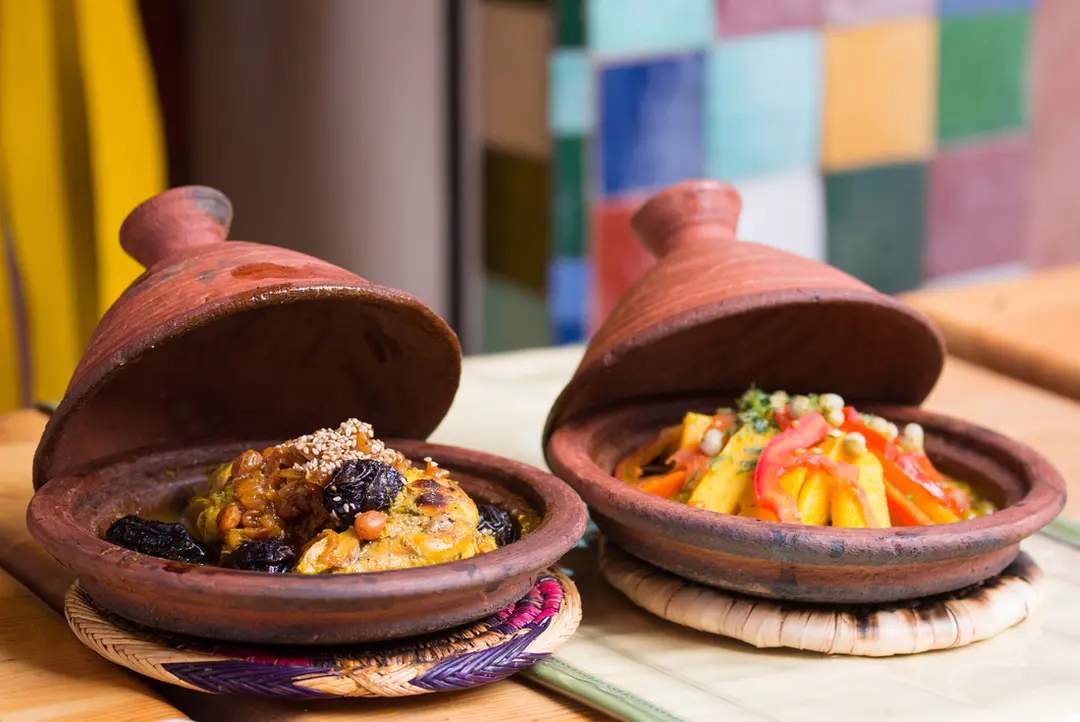

Following couscous, the initial culinary encounter for travelers in Morocco is the tajine. However, there’s often confusion surrounding what exactly constitutes a tajine. Essentially, the term “tajine” holds two distinct meanings. Primarily, it refers to a slow-cooked stew. Secondly, it denotes the vessel in which the dish is prepared; a tajine stew is traditionally cooked inside a specialized tajine vessel.
The Tajine, a centuries-old cooking vessel, is a remarkably simple pot with roots tracing back through the annals of history. Similar iterations of this pot are found in cultures across the globe. Crafted primarily from clay, the techniques employed in fashioning tajines and other clay pots date as far back as the Neolithic era. Although refined over time, the fundamental principles behind their construction have endured. In Morocco, two main types of tajines exist: glazed and unglazed versions. Additionally, intricately hand-painted tajines are available for purchase, primarily intended for serving rather than cooking.
Making a Tajine!

One common misconception about tajines is the belief in a singular type, whereas in reality, there are numerous variations. Tajine isn’t merely a dish; it embodies a diverse cooking method with myriad interpretations.
To craft a tajine, four essential components are needed:
1. The tajine pot
2. A selection of spices
3. Assorted vegetables, fruits, and/or meats
4. Water
The simplest form of tajine consists of vegetables. In Moroccan cooking, the key is to utilize seasonal ingredients, which heavily influence the contents of the tajine. Vegetables are arranged in layers, starting with the hardest at the bottom and progressing to the softest on top. They’re arranged in a circular pattern and stacked into a cone shape. Spices are incorporated either as a marinade or applied dry. Tomatoes frequently serve as an additional source of moisture and flavor. A small amount of water is also essential to prevent burning and generate steam during the cooking process.
In addition to their cooking method, tajines are renowned for their intricate flavor profiles. Their distinct blend of sweet and savory elements distinguishes them from other dishes. Some of the most popular tajines include chicken tajine with preserved lemon and olives, beef or lamb tajine with prunes and fried almonds, vegetable tajine featuring seasonal produce, fish tajine with peppers and tomatoes, and meatball tajine with tomato sauce and poached eggs. Seasonal delicacies such as lamb with peas and artichokes or beef with eggplants are also highly regarded. If given the opportunity to savor a unique tajine, whether in a home or restaurant setting, seize it! You may not encounter the same dish again during your visit.
The Tajine, a traditional cooking vessel, is a simple pot that has stood the test of time, with roots tracing back through centuries of culinary tradition.
Outside of Morocco, it’s common to find chefs and restaurants serving tajine with couscous on the side or even underneath the tajine itself. However, this practice is never observed in Morocco. Tajine and couscous are distinct meals, prepared and consumed differently. In Morocco, don’t anticipate your tajine to be accompanied by couscous. Instead, the dish is typically enjoyed with bread, which is used to scoop up the flavorful contents. Moroccans commonly eat from the area directly in front of them, especially when sharing a dish with others. It’s worth noting that individuals with gluten allergies or those opting for a low-carb diet may not find forks readily available, but it’s perfectly acceptable to request one if needed.